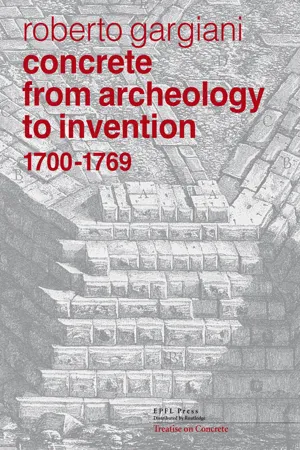
- English
- PDF
- Available on iOS & Android
Concrete, from archeology to invention 1700-1769
About this book
The reemergence in the early eighteenth century of the technology and use of concrete provide the starting point for this first volume of the Treatise on Concrete. In this book are described and analyzed, for the first time, the various contributions that led to the rediscovery of concrete made by the specialists of the period, from chemists to volcanologists; from engineers to architects and construction workers; from inventors to archaeologists and even men of letters. The book traces the various criteria for concrete production using local materials, from hydraulic lime to pozzolana and trass, as well as how the technique of casting concrete in formwork developed from construction-site practices that had survived locally from the times of ancient Rome. The subjects of the book include the transport of Roman pozzolana with which Italian, French, English or Danish engineers built grandiose offshore concrete structures; the genealogy of techniques for manufacturing wood formwork for foundations at sea, in rivers and above ground; the description of the various formwork systems invented to pour concrete in water; the research conducted by chemists on lime and pozzolana that led to the development of concrete; the invention of artificial stone, obtained using various types of cement; and the series of fantastic archaeological findings about the concrete structures of antiquity, which, even if sometimes baseless, nevertheless helped build confidence that this material could be invented. Finally, several great personalities in the history of architecture, such as Piranesi or Soufflot, are presented in a new light and are shown to be vital players in the affirmation of concrete in the eighteenth century. Thus emerges the first entry of a new history of concrete, one that will provide the essential principles needed to understand how the manufacturing methods discovered between the late eighteenth and early nineteenth century emerged and led to the production of this mythical material. This new history of concrete is clearly of present day interest, specifically in the context of recent research which aims to encourage concrete production using local materials, including volcanic constituents such as pozzolana – exactly as it was fabricated during the eighteenth century.
Frequently asked questions
- Essential is ideal for learners and professionals who enjoy exploring a wide range of subjects. Access the Essential Library with 800,000+ trusted titles and best-sellers across business, personal growth, and the humanities. Includes unlimited reading time and Standard Read Aloud voice.
- Complete: Perfect for advanced learners and researchers needing full, unrestricted access. Unlock 1.4M+ books across hundreds of subjects, including academic and specialized titles. The Complete Plan also includes advanced features like Premium Read Aloud and Research Assistant.
Please note we cannot support devices running on iOS 13 and Android 7 or earlier. Learn more about using the app.
Information
Table of contents
- Treatise on Concrete
- Table of Contents
- 1 Fantastic archaeology and artificial stones
- 2 Pozzolana, trass and lime for hydraulic construction
- 3 Major hydraulic works of the 1730s and 1740s
- 4 Apologia of Roman construction, from Soufflot to Piranesi to Winckelmann
- 5 Caissons and hydraulic mortars in the 1750s
- 6 Pozzolanas and newcement compounds, from Cronstedt to Loriot
- 7 Cement works in ports
- Name index